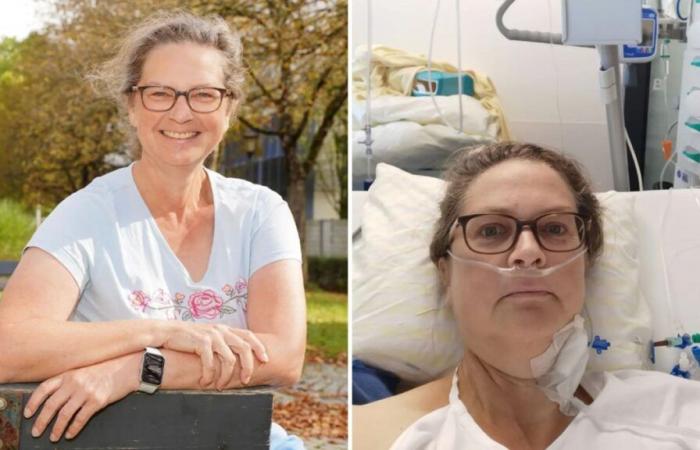
Heike Spreter-Krick, restored after septicemia.Image: dr
Heike Spreter-Krick came close to death. Even today, she feels the consequences of the septicemia that struck her. Why is this infection so dangerous? And what measures does Switzerland intend to put in place to better treat it?
29.04.2025, 05:2929.04.2025, 05:29
Adrian Ritter / ch media
HEIKE SPRETER-KRICK has long had to spend a summer working in a pasture for a long time. In 2021, her wish was realized: she joined a farm at altitude in the canton of Uri to help in trafficking in cows and the manufacture of cheese. But a few weeks later, everything changes.

Heike Spreter-Krick during his stay at the pasture.Image: dr
first, she feels difficulty swallowing, which she attributes to a simple cold. Then fatigue intensifies, a pain in the arm settles down, and it ends up losing consciousness. His condition is critical. REGU intervenes urgently.
When she regains consciousness, she is in intensive care at the cantonal hospital in Lucerne (Luks). The diagnosis falls: Septicemia. An infection of the blood that could have been fatal to him. The precise origin of the infection remains unknown. Maybe a simple insect bite?
Each year, sepsis affects around 50 million people worldwide. In Switzerland, the number of annual cases is estimated at 20,000, 3,500 of which are fatal. But what exactly is sepsis? “The term is misleading,” explains Dominic Huser, chief doctor at the Luks intensive medicine center.
“It is neither a blood -limited infection nor a conventional poisoning”
An infection that takes by surprise
Contrary to popular belief, sepsis does not result from a simple blood infection or poisoning in contact with a rusty object. It is always caused by an initial infection, most often of bacterial origin, but sometimes as viral.

Heike Spreter-Krick in intensive care.Image: dr
If pathogens can enter the body by a wound, this is not the main way of infection. “Bacteria can also penetrate through lungs, the abdominal cavity or urinary tract”, specifies Dominic Huser. When the immune system fails to contain the infection, germs spread throughout the body via blood circulation. The immune system then surrends, causing inflammation that can damage several organs.
“It is this excessive reaction that poses the greatest danger, even more than the bacteria themselves”
A difficult diagnosis and heavy consequences
Treatment is based on rapid administration of antibiotics to combat infection. However, as the doctor points out, the means of action on the causes “remain limited.
“The main thing is to detect sepsle as soon as possible in order to quickly start treatment”
The problem? The first symptoms often resemble those of a fludelaying the diagnosis and increasing the risk of serious complications. Some populations are particularly vulnerable: infants, people over the age of 60, those suffering from chronic or immunocompromised diseases. Heike Spreter-Krick was one of these risk profiles: former cancer patient, she has no spleen, an essential body for the immune response.
His case was extreme: bacteria attacked its heart valves and caused several strokes. She has also undergone lesions in hands and feet. After numerous surgical interventions and more than five weeks in the hospital, she was finally able to return to Germany for a long rehabilitation.
A national plan to better fight against septicemia
Due to the severity of this disease, Swiss medical societies launched in 2022 a “national action plan against sepsis”. His goal? Improve prevention, diagnosis and treatment. This plan aims to better train medical personnel and raise awareness of precursor signs.
It also provides for the implementation of standards for the management and post-processing of patients. Other countries, such as Australia, have already managed to significantly reduce mortality through similar initiatives. According to Dominic Huser, New technologies will play a crucial role.
“Digitization and artificial intelligence will allow access to relevant health data more quickly and to develop early alert systems for risky people”
Frequent long -term sequelae
Quickly detecting sepsis is crucial, as its consequences can be heavy, even among survivors. A study of the Iéna university clinic in Germany reveals that 90% of survivors suffer from long -term consequences: memory disorders, chronic pain, muscle atrophy, depression, etc.
Heike Spreter-Krick is no exception. It suffers from heart failure, persistent pain, mobility problems and post-septicemic syndrome that exhausts it on a daily basis. Despite everything, Dominic Huser tempers:
“We must not live in fear, but it is essential to know the signs of alert and to react quickly”
In matters of septicemia, The key is vigilance.
Translated and adapted by Noëline Flippe











